Jump to Section
Finches in the UK (Complete Guide with Pictures)
Last updated: 12 May 2022
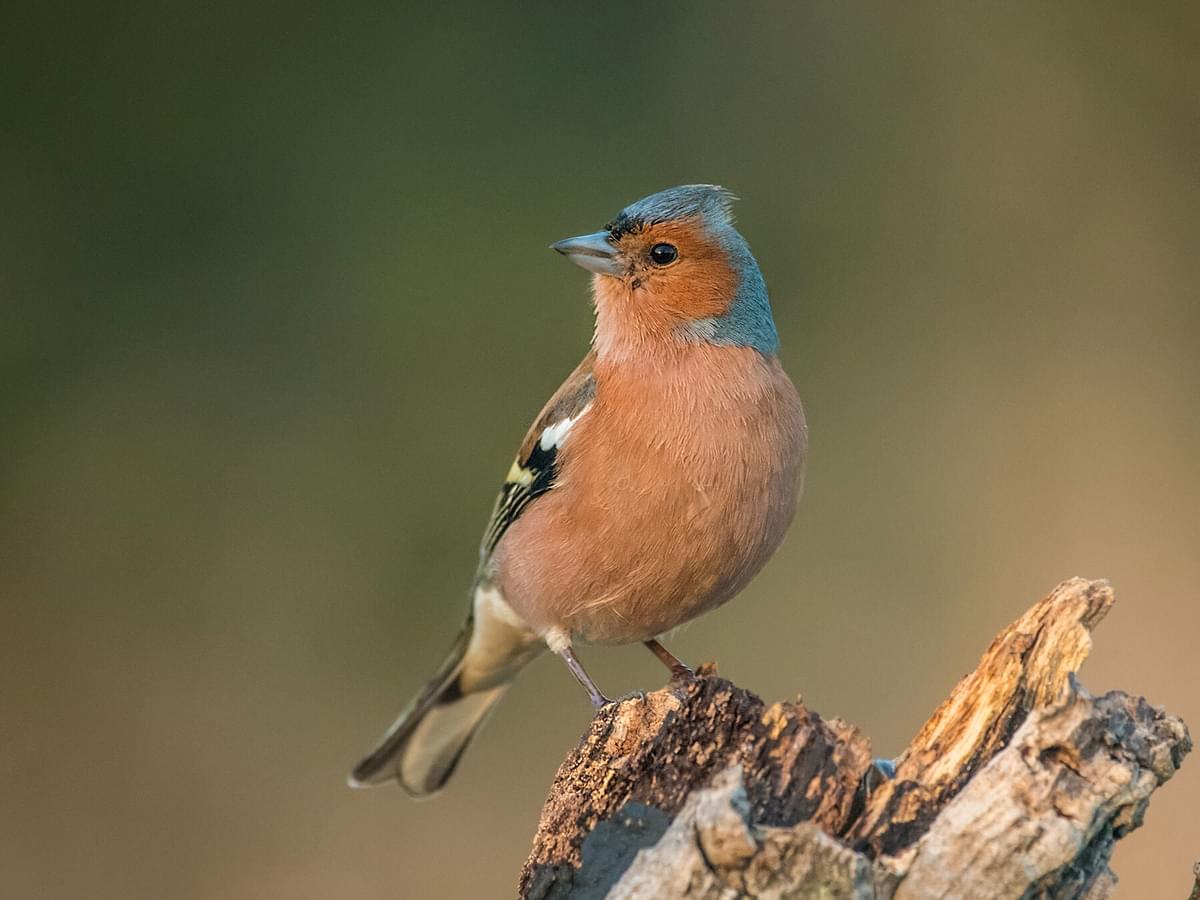
Finches are small-to-medium-sized songbirds, often colourful, with melodic songs and solid and specialised bills. They’re widespread throughout Europe, Asia, Africa and the Americas.
The True Finch family Fringillidae is large, containing some 234 species distributed across two subfamilies and 50 genera. There’s tremendous diversity amongst finches, and taxonomists are still unsure of how to group many of them.
Besides the large Fringillidae family, there are many other birds called finches distributed across other families, including Darwin's finches of the Galapagos Islands, which are now considered members of Thraupidae (the tanagers). Darwin’s finches were pivotal in his formulation of the theory of natural selection. Finches played a decisive role in our modern-day understanding of evolution.
Finches have had a close relationship with humans for thousands of years and are much-loved for their sociable, colourful nature and melodic songs.
The UK is home to its own fine selection of these diverse and beautiful songbirds. There are around 15 to 22 finches found in the UK, though some are rare visitors or end up here as vagrants from as far as North America.
This is a guide to finches in the UK!
Common Finch species in the UK
The British finches below are generally the most likely ones you're going to spot in the UK (location dependant).
European Goldfinch
Carduelis carduelis
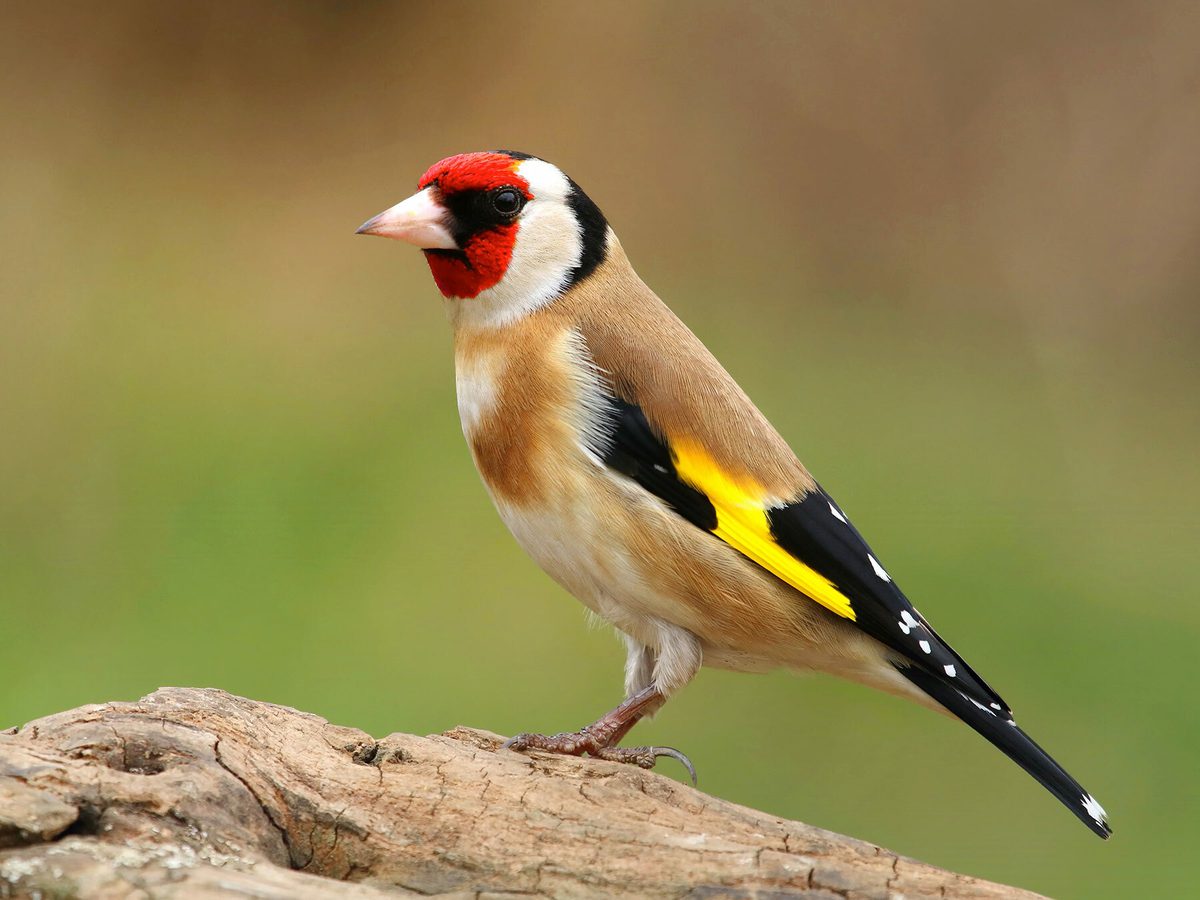
Length:
12cm to 13cm
Wingspan:
21cm to 25cm
Weight:
14g to 19g
European Goldfinch
The common European goldfinch, also just called the goldfinch, is native to Europe, North Africa, and much of Asia. There are four subspecies of goldfinch - the UK is home to the carduelis subspecies, which is distinctively coloured with a red face and black and yellow wings.
Though they’re found throughout much of the UK and Ireland, goldfinches are most common in southern England. Their pointed bills enable them to retrieve seeds and berries that other species of birds can’t easily access. Goldfinches have a delightful and recognisable song, and are capable of mimicking elements of other birds’ songs.
There are approximately 1.5 to 1.7 million goldfinches in the UK.
Appearance
European goldfinches are small and slender, measuring 12 to 13cm long with a wingspan of around 21 to 25cm. They weigh around 14 to 19g. They’re distinctively coloured with a red face, white and brown bodies and black and yellow striped wings. The male and female are similar, but the female lacks much of the red parts of the male.
Chaffinch
Fringilla coelebs
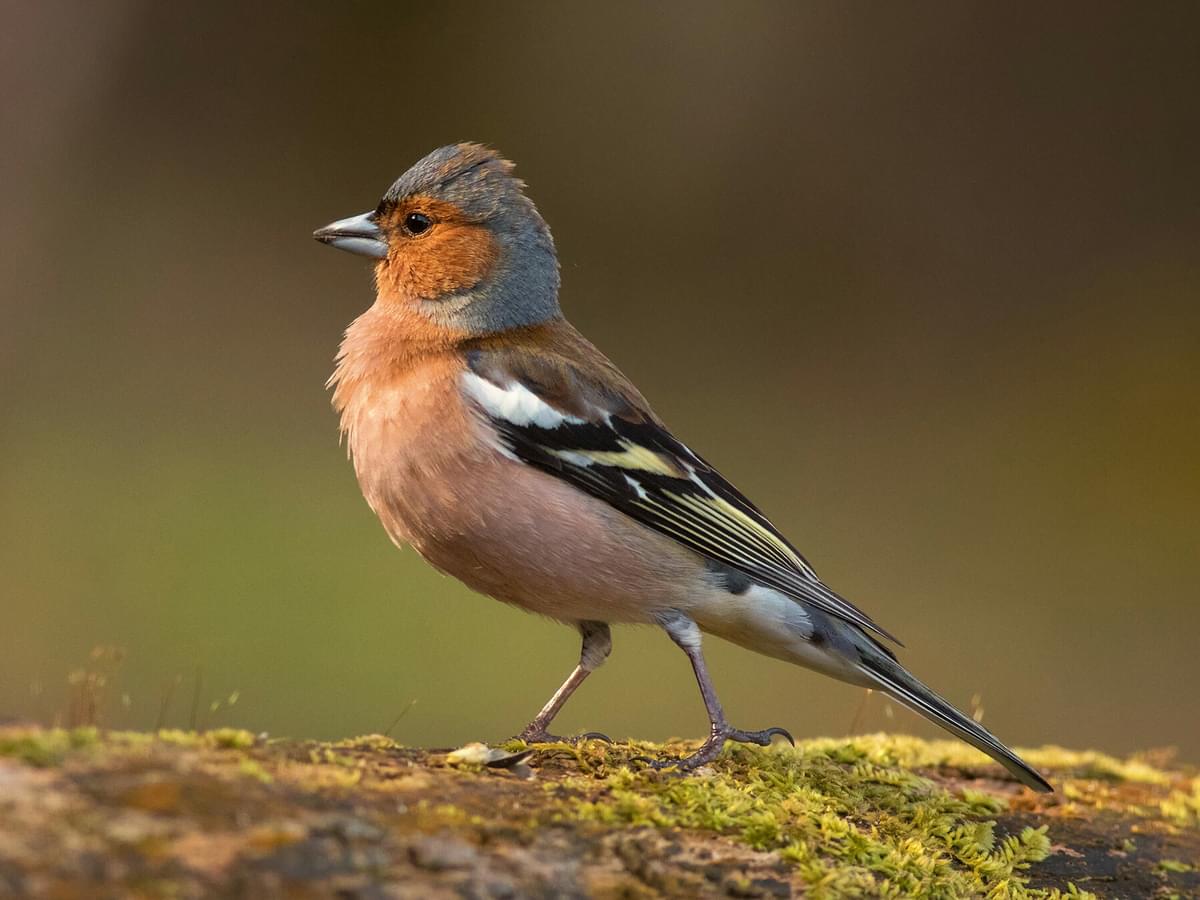
Length:
14cm to 16cm
Wingspan:
24cm to 28cm
Weight:
18g to 29g
Chaffinch
The Chaffinch is the UK’s most common finch and the second most common breeding bird overall. There are around 6.2 million in the UK and a further 2 million in Ireland.
The Chaffinch is regularly reported as one of the top 10 birds observed in the RSPB’s Big Garden Birdwatch, though it doesn’t usually feed openly from bird feeders. While the UK has a large population of resident chaffinches, numbers are boosted by migrants from northern Europe.
Chaffinches are melodic birds with a diverse range of songs. They even have regional dialects. Though found mostly in deciduous forests, chaffinches have adapted to many habitats, including urban areas.
Appearance
Chaffinches measure 4.5 cm long, with a wingspan of 24.5 to 28.5cm and weigh around 18 to 29g. They're one of the most colourful UK finches, especially in the case of the male.
The male has a bluish cap with pink cheeks and a pinkish-red breast. Contrastingly, the female is almost all grey-brown with whitish underparts. Both the male and female have distinctive wing bars.
Greenfinch
Chloris chloris
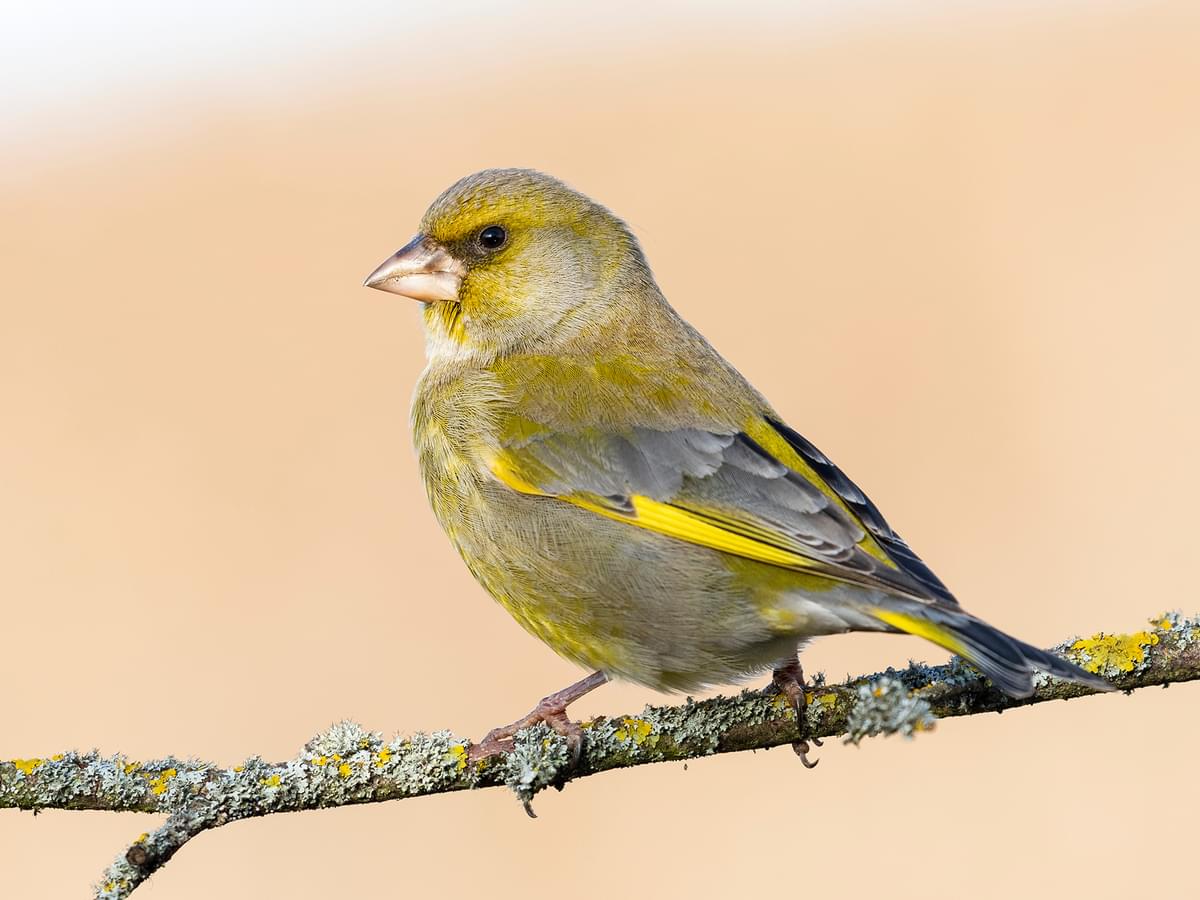
Length:
14cm to 16cm
Wingspan:
24cm to 28cm
Weight:
25g to 35g
Greenfinch
Native to Europe, North Africa and Southwest Asia, the greenfinch is one of the UK’s most common resident garden birds. This colourful character is a distinctive green and has a whistling, almost wheezing song that it frequently sings as it weaves through the sky.
Greenfinch populations are not particularly stable in the UK and fluctuate with outbreaks of the parasite trichomoniasis. Consequently, greenfinches are currently listed as Red under the Birds of Conservation Concern 5: the Red List for Birds.
Greenfinches have large, conical bills that are typically finch-like. They’re boisterous and sociable characters that build large, bulky nests in conifers and deciduous trees. There are around 1 to 1.5 million greenfinches in the UK.
Appearance
Greenfinches are around 15cm long and have a wingspan of 24.5 to 27.5cm. They weigh approximately 28g.
Greenfinches are a light-to-olive green with a dark eye patch. The bodies and wings have grey patches, and the wings have a bright yellow flash. Greenfinches also have darker parts to their tales and a whitish underside. The females are similar but duller overall.
Linnet
Linaria cannabina
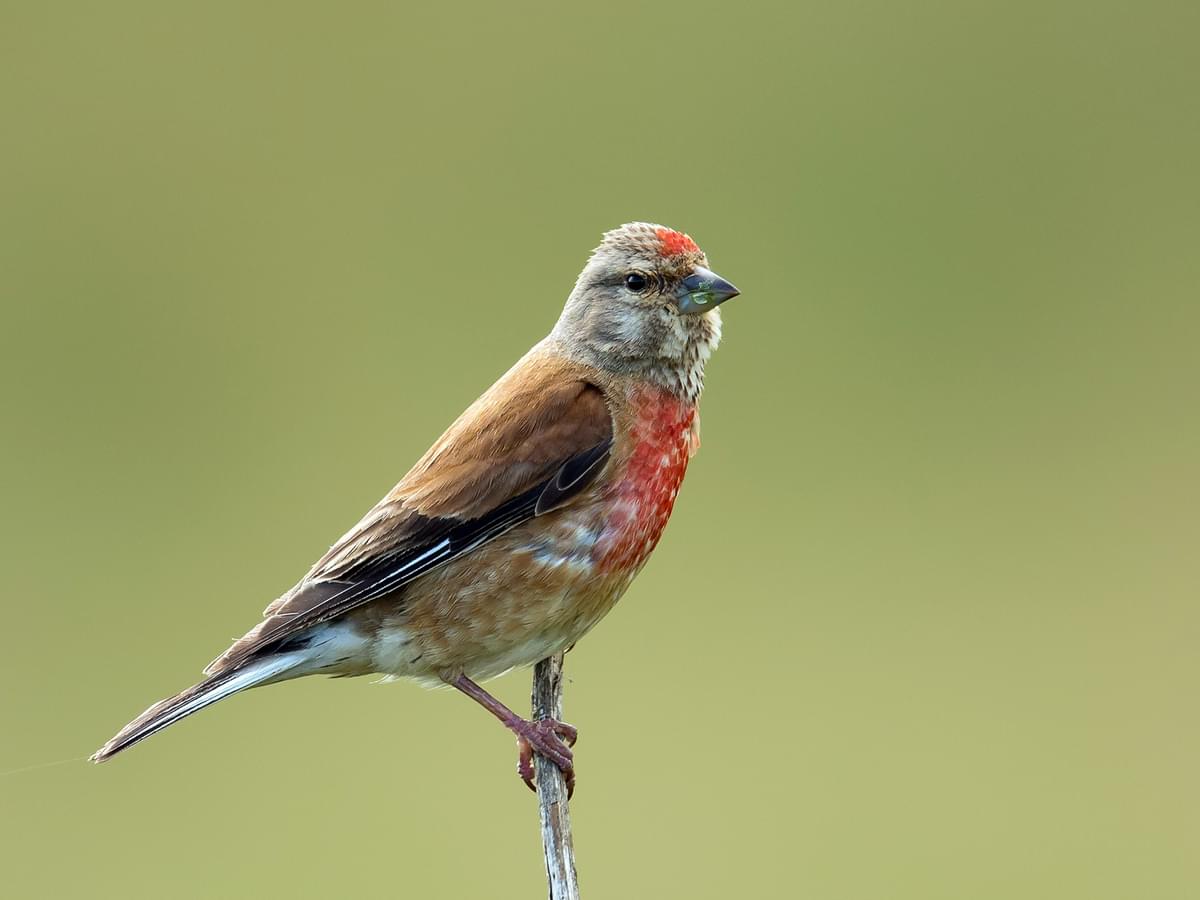
Length:
13cm to 14cm
Wingspan:
21cm to 25cm
Weight:
15g to 20g
Linnet
A small finch with a crimson breast, the Linnet is much more abundant in the south of England than it is in Scotland and Northern Ireland. This primarily granivorous bird used to be kept as cage birds because of its melodic song and feature in many poems and literary works.
Today, their populations are dwindling rapidly and have decreased by over 50% in the last 50 years. Linnets are currently listed as Red under the UK’s Birds of Conservation Concern 5: the Red List for Birds.
Linnets nest mainly in hedgerows and dense foliage and build compact, neatly rounded nests. Linnets are actually named after one of their favourite seeds, as their name is derived from linseed, from the flax plant.
Appearance
Linnets are slender, measuring around 13.5cm with a wingspan of 21 to 25.5cm. They weigh 15 to 22g. They have a grey-brown upper body, a light-brown underside and a distinctive crimson breast. Their tail feathers are blackish. Females are duller, lacking pretty much any red.
Bullfinch
Pyrrhula pyrrhula

Length:
14cm to 16cm
Wingspan:
22cm to 26cm
Weight:
21g to 27g
Bullfinch
The plump Bullfinch is a fairly rare visitor to UK gardens. If you do see one, you’ll probably remember it for its pink-red breast, pink face, and black head. At least, that’s the case with the male - the female lacks practically any pink/red! Bullfinches are known to be extremely shy and are careful when they visit gardens.
Bullfinches used to be persecuted as they often eat the buds from fruit trees, but it’s now illegal to trap and kill Bullfinches. They’re listed as Amber under the UK’s Birds of Conservation Concern. There are around 200,000 pairs in the UK.
Bullfinches are unique amongst finches as they have food sacs in the base of their mouth. This food sac allows them to travel greater distances to forage, enabling them to transport more food to their chicks. In addition, this helps the birds isolate their nests from others.
Appearance
Bullfinches are one of the most distinctive finches, at least in the case of the red/pink-breasted male. The female lacks any pink and has a light-orange-to-brown breast. Both the male and female have dark wings, tails and heads. Their bills are very short and broad.
Brambling
Fringilla montifringilla
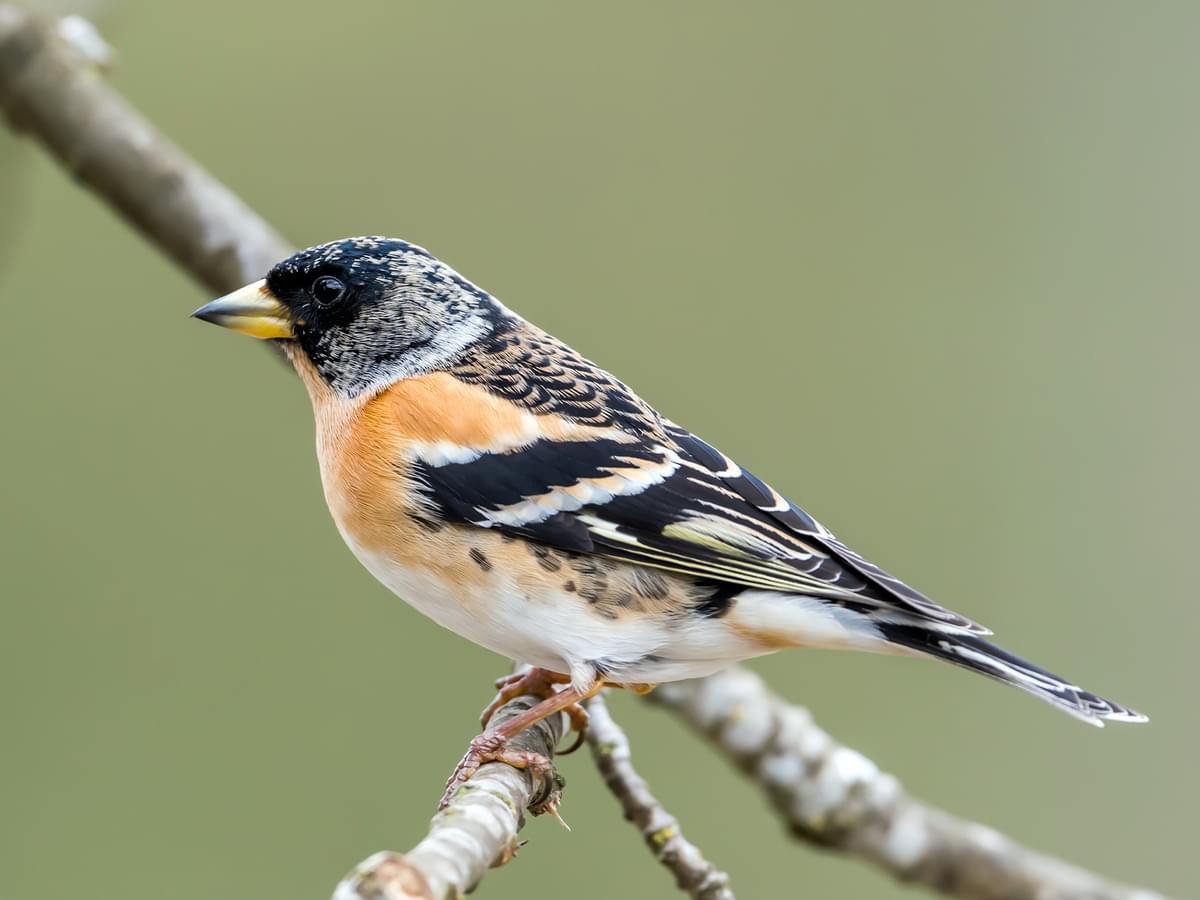
Length:
14cm to 16cm
Wingspan:
23cm to 26cm
Weight:
18g to 29g
Brambling
Bramblings are a winter visitor to the UK, migrating from much of northern Europe, Scandinavia, Finland, Iceland, Russia and East Asia. Approximately 1 to 2 million arrive in the UK starting as early as September, and they’re often spotted in large gregarious flocks.
Brambling flocks can range into the hundreds of thousands. Most Bramblings leave the UK again in early spring, but some stay as late as May. It’s rare for any Bramblings to breed in the UK, even in Scotland.
Appearance
Bramblings are closely related to Chaffinches, and they look very similar, sporting a white rump, brown-orange breast and rusty brown and black wings. These are fairly large amongst finches, probably because they breed in cold northern regions. They’re around 16cm long with a wingspan of 25 to 26cm, and weight between 23 to 29g.
Breeding male Bramblings have a distinctive black head which they lose in the winter. Bramblings are similar to chaffinches, to which they’re closely related, but differ in their spotted sides, size (Bramblings are larger) and their white rump (the Chaffinch has a greenish rump).
In the UK, Chaffinches and Bramblings often form large mixed flocks.
Eurasian Siskin
Spinus spinus
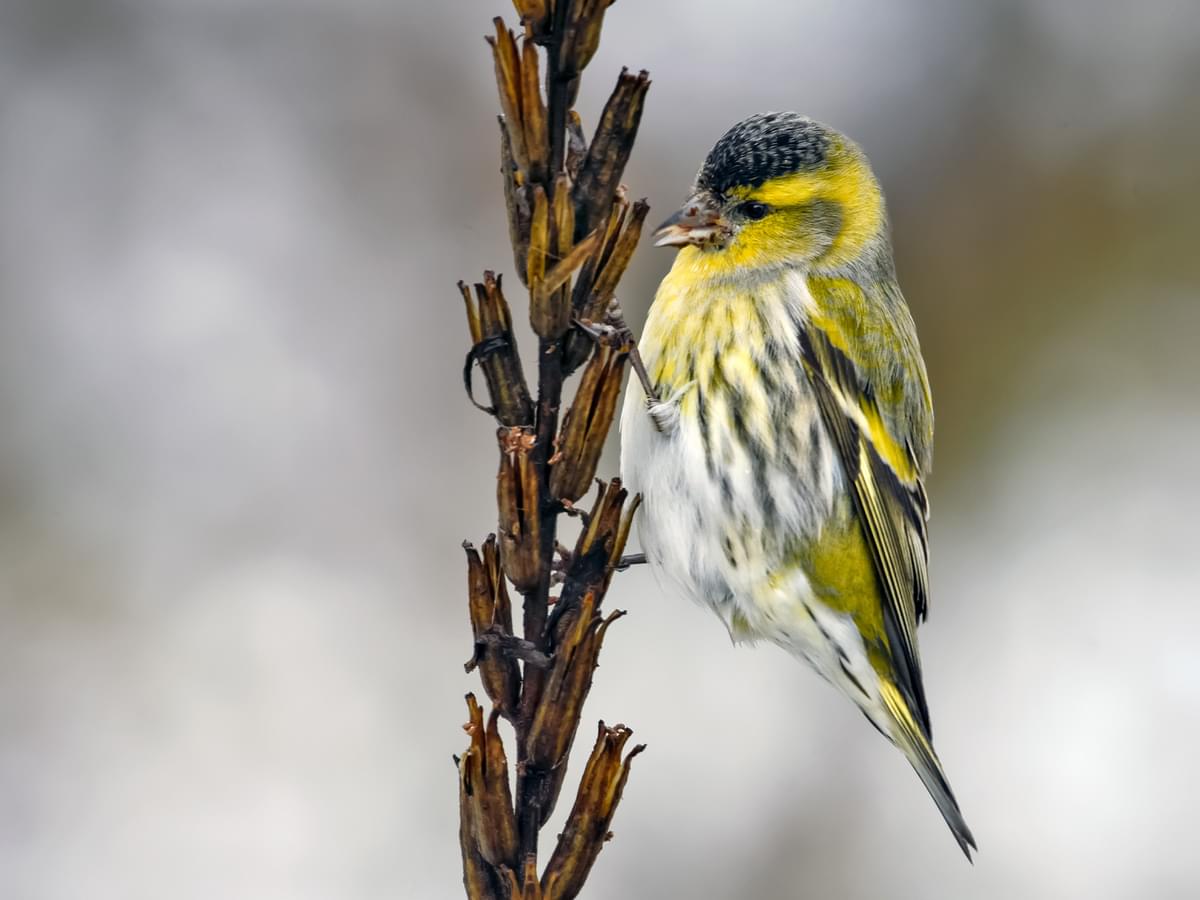
Length:
11cm to 12.5cm
Wingspan:
20cm to 23cm
Weight:
10g to 18g
Siskin
Siskins are small lively finches which are most numerous in Scotland or Wales, where their numbers swell from migrants leaving northern Europe.
Inhabiting dense woodland, Siskins are more common than most people think, despite being one of the lesser-known common finches. Siskins are somewhat similar to greenfinches, but they have darker, striped wings and the males have a distinctive dark cap.
The Siskin is one of the liveliest of all the finches - they’re restless little birds that rarely stop moving! However, they’re also quite calm around humans and will even feed from the hand.
Appearance
Siskins are smaller than greenfinches, measuring around 11 to 12.5 centimetres, with a wingspan of 20 to 23 centimetres. They weigh between 10 to 18 grams. This makes them one of the smallest of the UK’s finches. Siskins are streaky yellow-green with a black-brown cap for the male. The wings are black and yellow and are much more defined than greenfinches.
Lesser Redpoll
Acanthis cabaret
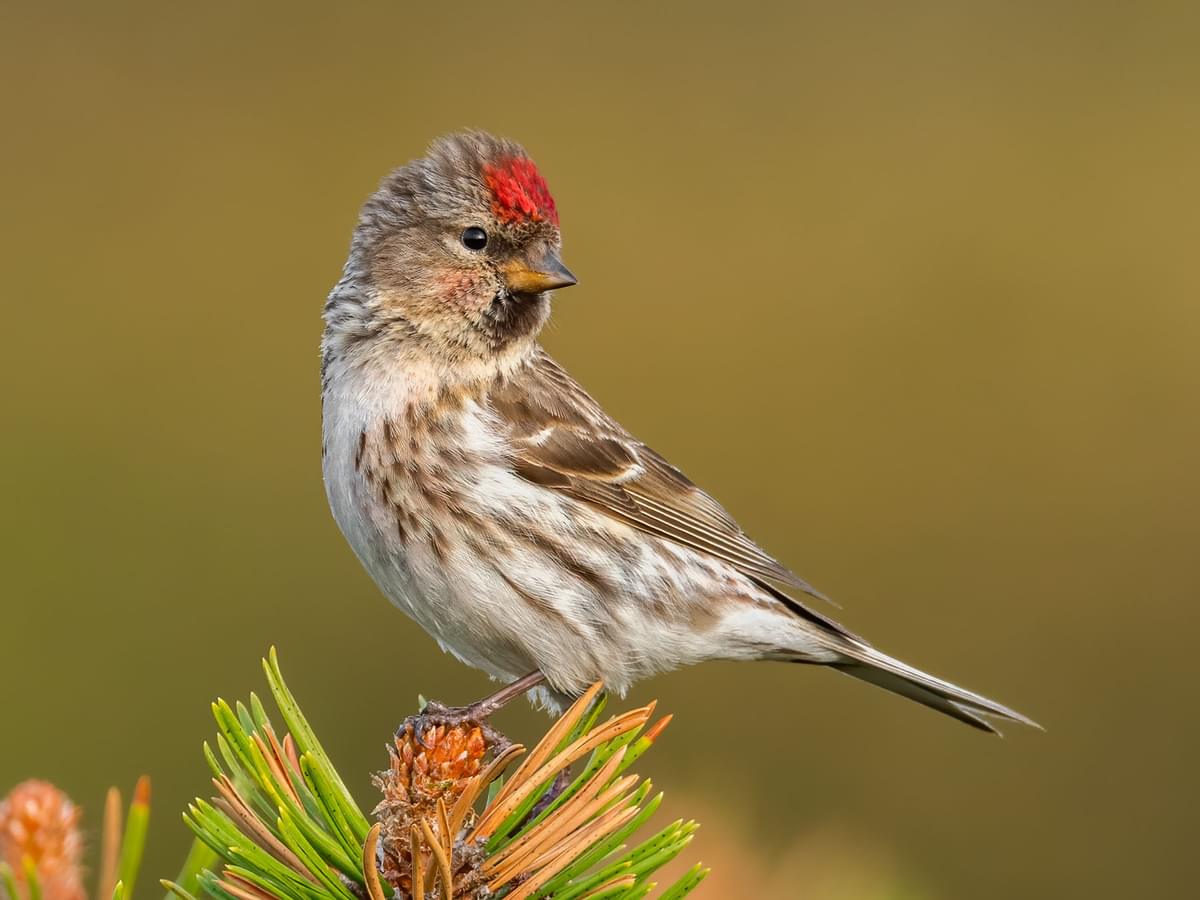
Length:
11cm to 13cm
Wingspan:
20cm to 22.5cm
Weight:
9g to 12g
Lesser Redpoll
The Lesser redpoll was recently split from its larger relative, the Common redpoll, and is also similar to the Arctic redpoll, which is an occasional winter visitor to the UK. Though Lesser redpolls do breed in the UK, mainly in the North, Scotland, Wales and Northern Ireland, they typically migrate. Some migrants arrive from northern Europe, while others leave for France, Belgium and Spain.
Due to depleting numbers, Lesser redpolls are currently listed as Red under the Birds of Conservation Concern 5: the Red List for Birds. However, there is evidence that more of these birds are visiting the UK in winter than was once the case.
Appearance
Lesser redpolls are small finches with streaked brown and beige wings and upper parts. The males have a distinctive red cap. Their bills are particularly short and conical. They measure 10.5 to 12.5 centimetres long with a wingspan of 20 to 22.5 centimetres and weigh around 9 to 12 grams.
Lesser redpolls are remarkably similar to Common and Arctic redpolls. Arctic redpolls have buff-white plumage, whereas Lesser redpolls are more beige-brown and Common redpolls are ‘colder’ in appearance, and are larger than Lesser redpolls.
Twite
Linaria flavirostris
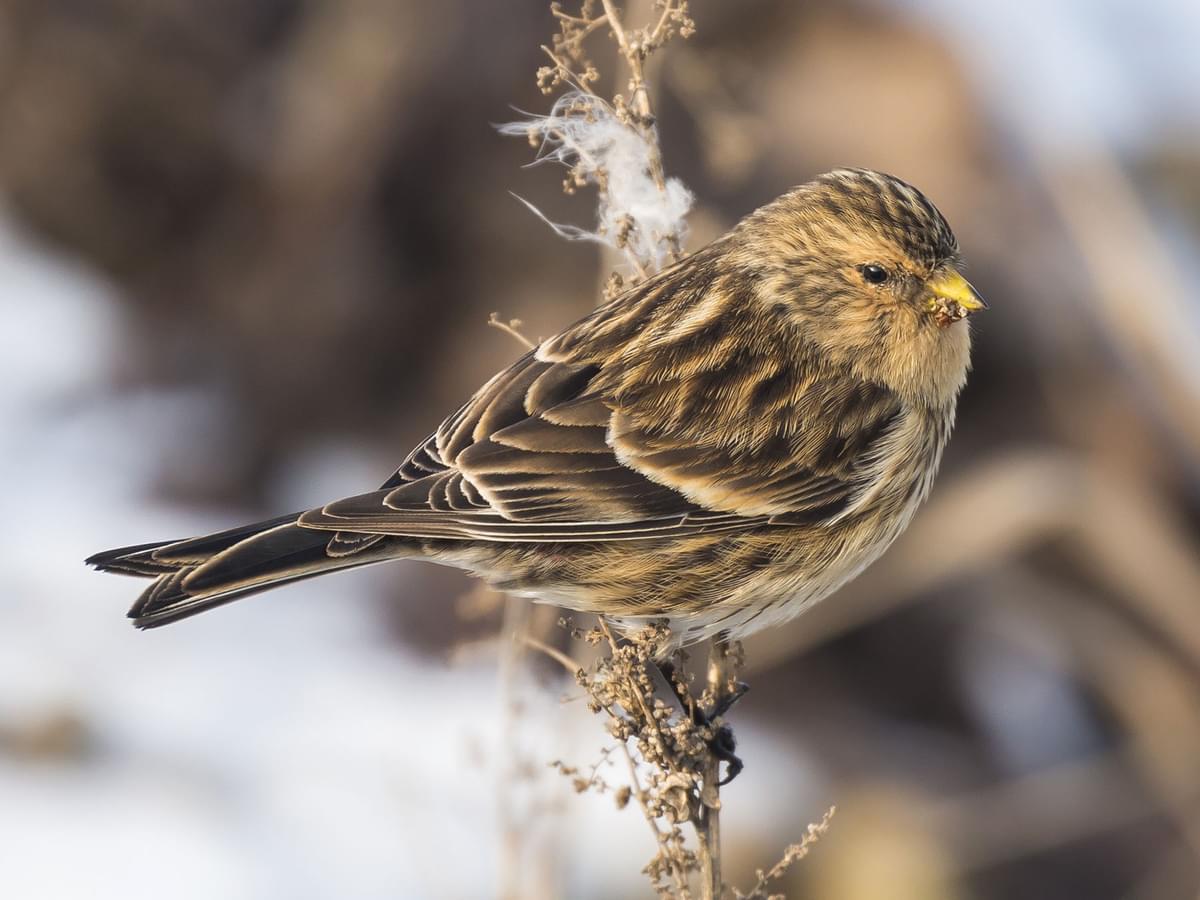
Length:
13cm to 14cm
Wingspan:
21cm to 23cm
Weight:
15g to 20g
Twite
The uncommon Twite breeds in Scotland, the Pennines and North Wales, as well as across the Scottish islands and parts of Northern Ireland.
There are only roughly 10,000 breeding pairs in the UK. The migratory habits of the Twite are poorly understood, and their populations are concentrated in small pockets. For example, in Wales, Twites are almost exclusively found in Flintshire. Most migrate eastwards and southwards during winter, ending up in much of Central Europe.
Appearance
Twites are similar to the Linnet, but are slimmer with a stubbier, yellow bill. Their plumage is a generic streaky brown. They also lack the crimson breast that the male Linnet has during the breeding season, and the red head cap of the redpolls. Twites are extremely hard to tell apart from Linnets outside of the breeding season - both look like ‘little brown birds’.
Red Crossbill
Loxia curvirostra
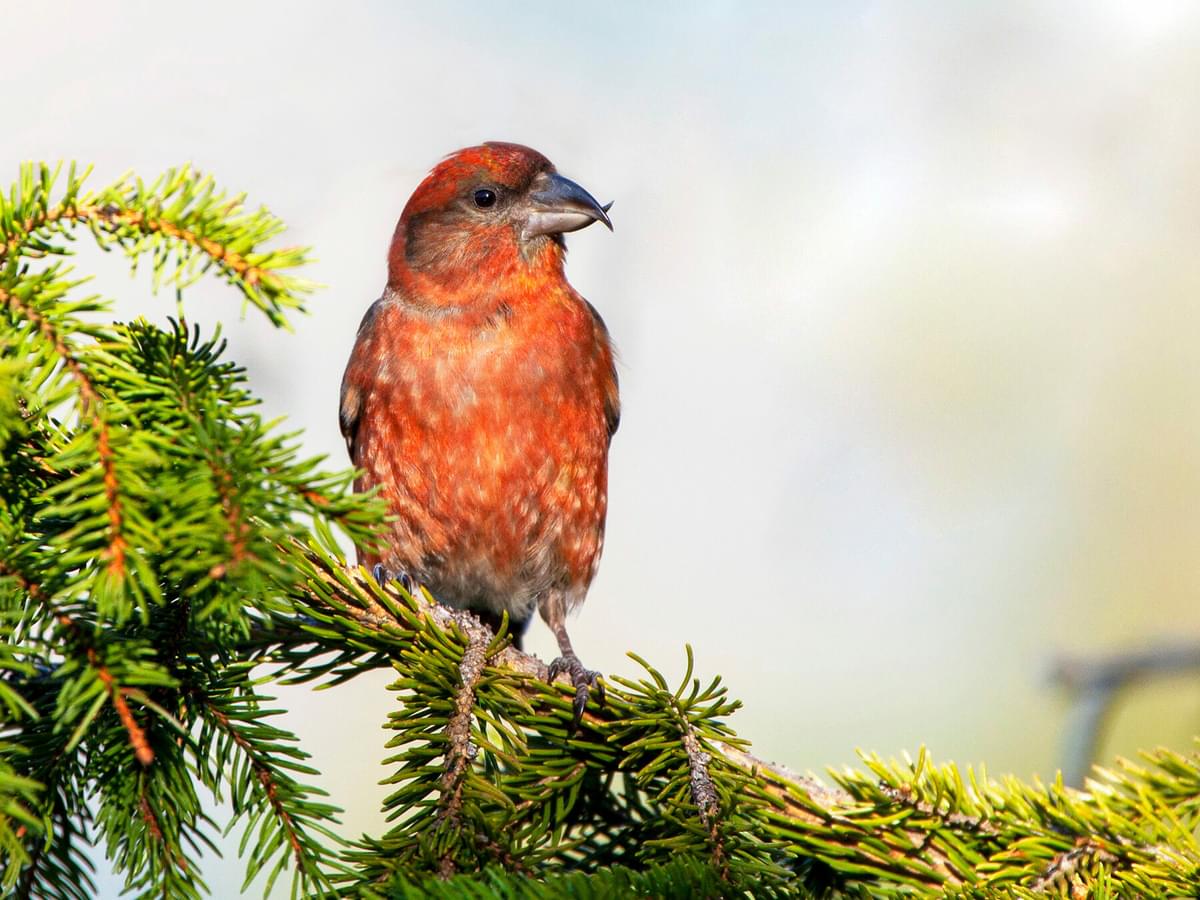
Length:
15cm to 17cm
Wingspan:
25cm to 28cm
Weight:
30g to 53g
Common Crossbill
The Crossbill is a unique finch with a crossed beak, which evolved to help it prize pine seeds from pine cones. Crossbills are fairly widespread throughout the UK and breed in the conifer forests of the Scottish Highlands, the North Norfolk coast, the New Forest, Breckland and the Forest of Dean.
There are actually three species of crossbills in the UK - “crossbill” is a genus, and not a species. These include the Scottish crossbill, the Parrot crossbill and the Red crossbill, also called the Common crossbill. Parrot and Scottish crossbills are rare in the UK.
A favourite amongst birders, crossbills are often spotted when they arrive at pools to drink. Their migratory habits are rather chaotic, as many winter arrivals from northern Europe stay in the UK to breed. They also spread across the UK in what is known as “irruptions”, usually in response to food shortages. Crossbills disperse throughout practically every region in the UK in an irruptive year.
Appearance
Crossbills are large finches, measuring around 20cm with a wingspan of almost 30cm. They weigh around 40 to 53g, which is two to three times more than other finches. But, of course, the headline here is this bird’s unique bill, which crosses over at the tip.
This bill enables the bird to pry a seed from within a conifer cone’s scales, then twisting the lower mandible to release the tongue as the bird continues to grip to see.
Less common Finch species in the UK
Although some of these finches can still regularly be seen, you're generally less likely to come across them than the birds above.
Common Redpoll
Acanthis flammea
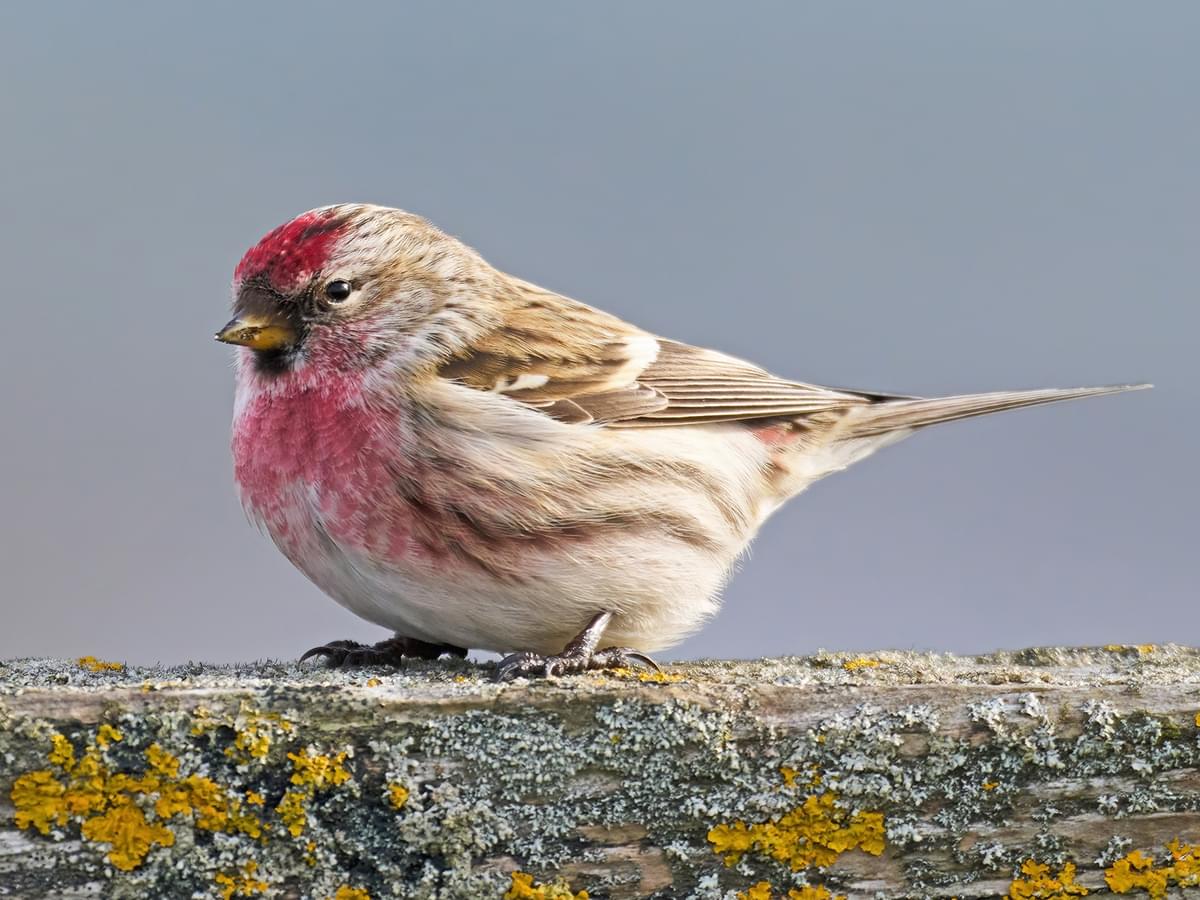
Length:
11.5cm to 14cm
Wingspan:
19cm to 22cm
Weight:
10g to 18g
Common Redpoll
The Common redpoll is less common than the Lesser redpoll, which is remarkably similar aside from being smaller on average. Common redpolls are highly specialised to their Arctic and Sub-Arctic habitats, which is where they breed. In fact, they’re one of the most cold-hardy songbirds in the world.
Common redpolls are a rare winter visitor to the UK, where they’re most likely to be spotted on the East Coast. Migrants from Iceland and Greenland usually head further into Western and Central Europe. There are just a few hundred Common redpolls in the UK each winter.
Appearance
The Common redpoll is similar to the Lesser redpoll, and they were once considered the same species. The Common redpoll is larger, measuring around 10.5 to 14 centimetres long with a wingspan of 19 to 22cm, weighing around 12 to 16g.
Conversely, the Lesser redpoll weighs around 9 to 12g. They’re also darker overall than the Lesser redpoll.
Hawfinch
Coccothraustes coccothraustes

Length:
16.5cm to 18cm
Wingspan:
29cm to 33cm
Weight:
48g to 62g
Hawfinch
The Hawfinch is massive amongst the UK’s other finches, and has a colossal conical bill which it uses to pry buds and eat large seeds. Hawfinches are rare in the UK, with a breeding population numbering around 1,000 birds, which increases to around 15,000 in winter.
In addition to being rare, Hawfinches are shy and elusive, spending much of their time in deep forest canopies. Even their songs are known to be very soft, making them hard to track down and spot.
Nevertheless, Hawfinches do have a few strongholds in the north and south of Wales, southern Scotland, the Forest of Dean, the New Forest and Breckland. In addition, Bedgebury Pinetum in Kent is well-known for hosting small flocks of feeding Hawfinches.
Hawfinch numbers in the UK are low, but have increased from the 19th-century. Even so, this is yet another of the UK’s Red List finch species, and their futures are uncertain.
Appearance
Hawfinches are beautiful large finches, measuring around 18cm long, with a wingspan of 29 to 33cm and weighing about 46 to 70g. Hawfinches are robust, stocky finches with large metallic bills. They’re primarily chestnut brown, with grey sides, a darker back and white and black wings.
Hawfinch males are pretty similar to males. These finches engage in an elaborate courtship dance and form strong monogamous bonds.
Common Rosefinch
Carpodacus erythrinus
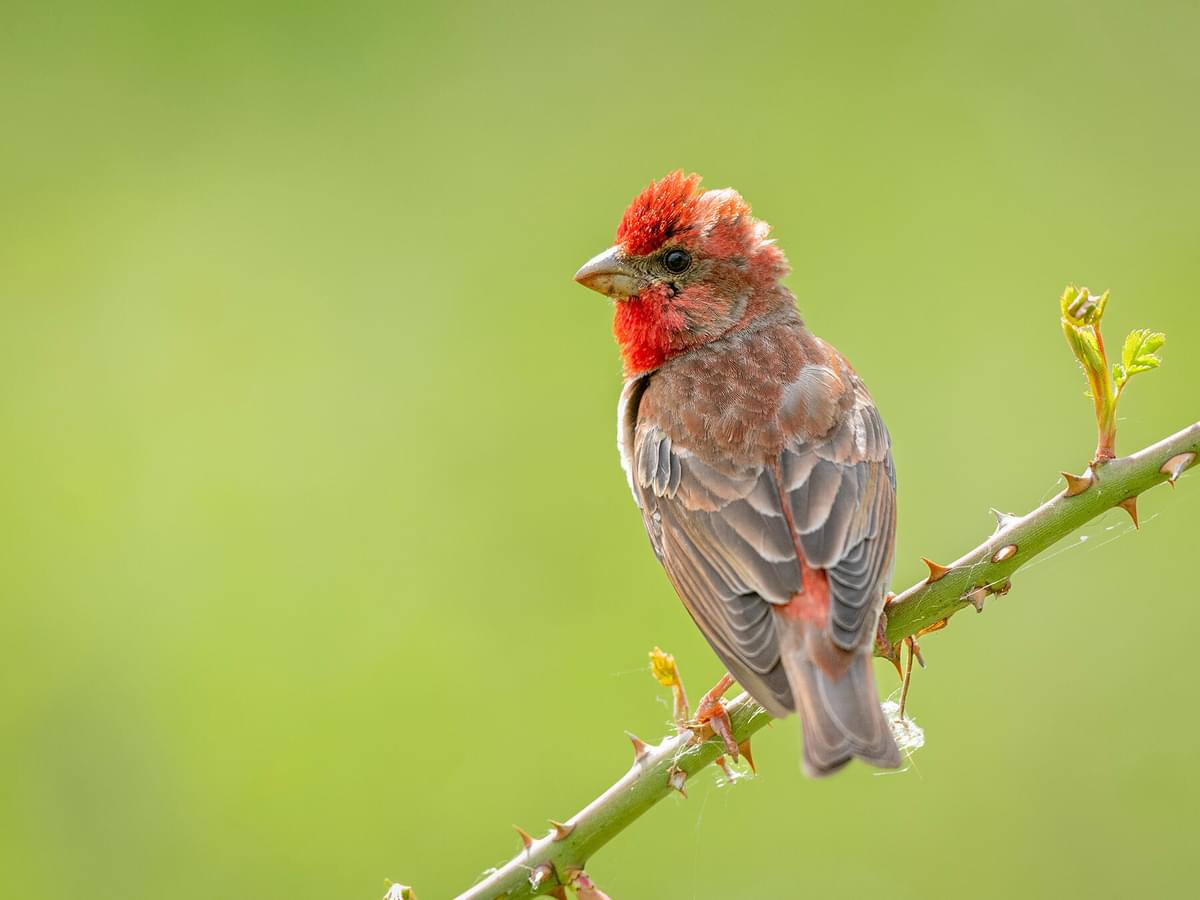
Length:
13cm to 15cm
Wingspan:
22cm to 26cm
Weight:
19g to 27g
Rosefinch
The aptly named Rosefinch lives across much of northern Europe and Asia. Only a few hundred arrive on the UK’s east coast each winter. There are sporadic breeding records of Rosefinches in the UK, but this is certainly a rare occurrence.
You’re most likely to see one along the coast of eastern Scotland, the eastern Scottish Isles and the east and southeast of England. Rosefinches found in the UK are usually vagrants from other parts of Europe.
Appearance
Rosefinches are rose-scarlet coloured in the case of the male. The rose plumage is concentrated on their heads, necks and breasts. The female is much paler and drabber with virtually no coloured plumage at all.
Rosefinches are medium-sized finches; they’re around 14.5 to 15cm long with a wingspan of 22 to 26cm and weigh around 21 to 27g.
Serin
Serinus serinus
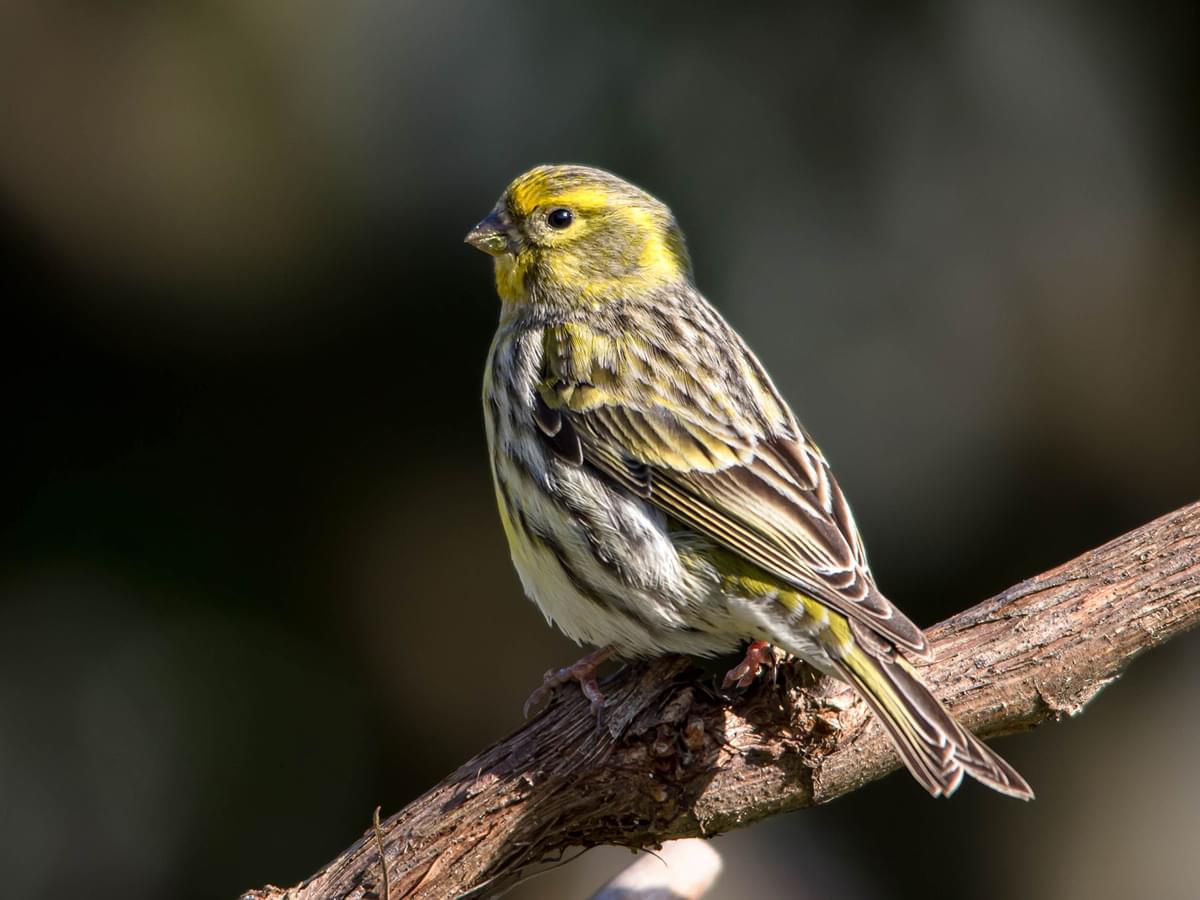
Length:
11cm to 12cm
Wingspan:
20cm to 23cm
Weight:
10g to 15g
Serin
The Serin is the smallest European finch and is closely related to the Atlantic canary. This slender finch prefers the warmer interior of southern and Central Europe to the UK and is abundant in France and Spain. Handfuls of migrating or dispersing Serins end up on the UK’s south and southeast coasts each spring and summer.
This has become more common since the 1960s, and a small number of breeding pairs have been observed in Devon, Dorset, Sussex, East Anglia and Jersey. However, visiting Serins account for no more than around 100 individuals, and sightings outside of spring are exceptionally rare.
Appearance
Serins are slim, small finches. The males have yellow breasts, heads and necks, with yellow and black striped wings. Their tails are long and forked.
The females are much duller, with only faint yellow. Serins measure around 11 to 12cm with a wingspan of 18 to 20cm and weigh 12 to 15g.
Parrot Crossbill
Loxia pytyopsittacus
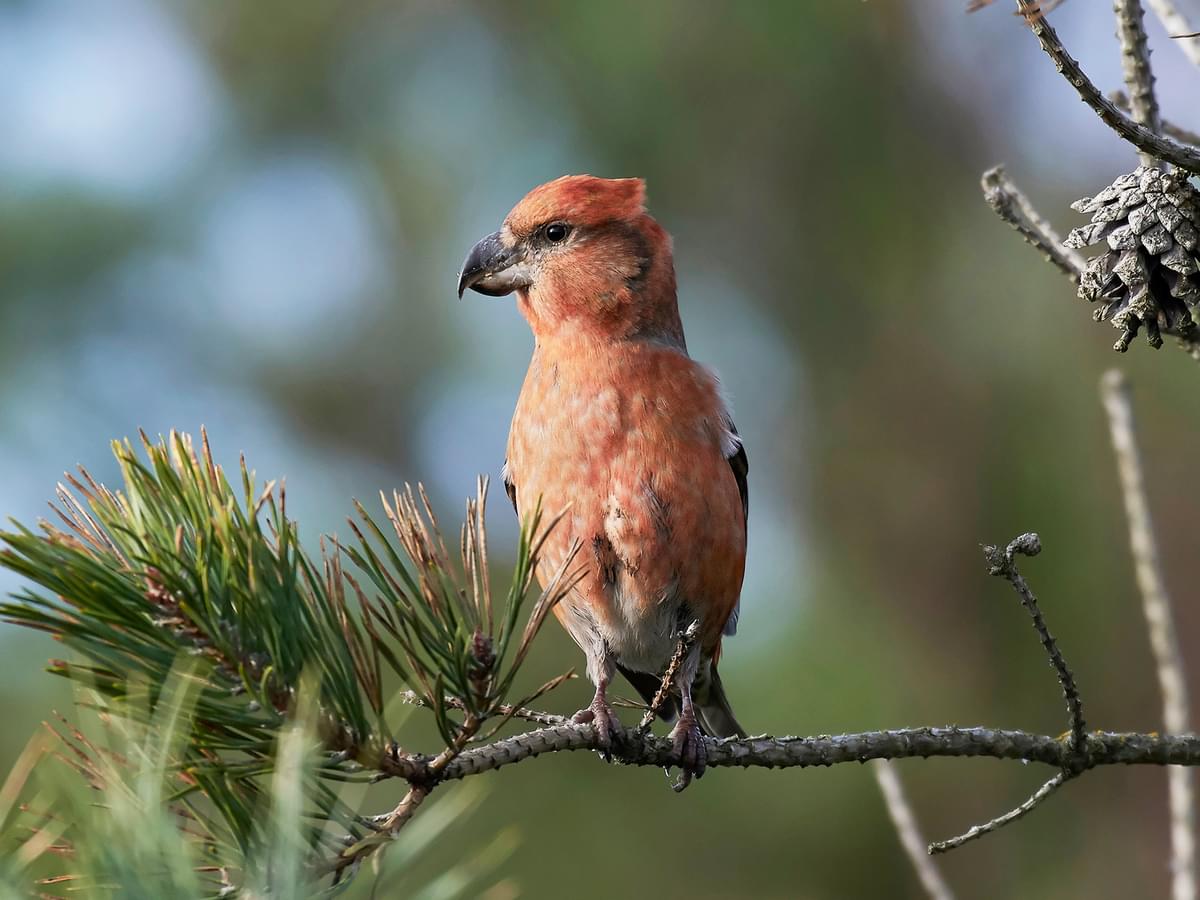
Length:
16cm to 18cm
Wingspan:
27cm to 30cm
Weight:
40g to 53g
Parrot Crossbill
The Parrot crossbill is an uncommon crossbill of Northern Europe. In the UK, they occur almost exclusively in Scotland where there are an estimated 50 breeding pairs, with higher numbers in winter as migrants arrive from Scandinavia.
Their range in Scotland is confined to the Scottish Mainland and very rarely Orkney, Fair Isle, Shetland and the Outer Hebrides.
Appearance
Parrot crossbills have thicker bills than Common and Scottish crossbills. Their head is very thick and powerful, with practically no forehead. The males are red to rusty red across much of the breast, body and wings, but the females are a green-yellow.
Parrot crossbills measure 16 to 18cm long with a wingspan of around 30 to 34cm and weigh approximately 48 to 61g. This makes them marginally heavier than the Common crossbill.
Scottish Crossbill
The Scottish crossbill is the UK’s only fully endemic species of bird, which means that it doesn’t occur anywhere else in the world. However, there is some debate as to whether this species is truly different from the Parrot and Red crossbills, which are near-identical.
Nevertheless, the British Ornithologists Union classed the Scottish crossbill as a separate species in 1980. DNA evidence collected since then seems to suggest that the Scottish crossbill is indeed genetically distinct from the other crossbills.
There are an estimated 6,800 breeding pairs of Scottish crossbills, which are confined to Scots pine forests across the Scottish Highlands, Caledonian forests and mainland farmland. Ornithologists are sceptical of whether they’re found on Scottish islands.
Appearance
Like other crossbills in the UK, the Scottish crossbill is a heavy, robust finch with a large, crossed bill. Its bill is not as thick as the Parrot and Common crossbill, but the difference is subtle. Overall, it’s pretty much impossible to positively identify a Scottish crossbill without extensive observational evidence and recordings of its call.
Naturally, there is much controversy about the three species of crossbills present in the UK; the Scottish, Parrot and Common crossbill. Not only are these species extremely similar, but ornithologists are unsure of how to objectively identify them for the purposes of surveys.
While calls were once seen as a deciding factor in identification, a paper published by the Scottish Ornithology Club in March 2022 states that Scottish crossbills can no longer be positively identified based on their “type C” excitement call.
What are finches?
A seemingly simple question with an exceedingly complex answer!
Like many large groups of small birds, finch classification is an intractable problem. So, it's not an easy task to define what a finch actually is.
Today, the True Finch family from the Order Passeriformes is usually split into two subfamilies, the small Neotropical Euphoniinae family and the much larger Carduelinae family. The latter family also contains species known as grosbeaks, siskins, serins, redpolls, canaries and euphonias, some of which inhabit the UK. There are over 200 True Finches divided into around 50 genera.
To confuse matters further, there are many birds placed in other families which are also called "finches". These include Estrildidae, of the Pacific Islands and Australia, a few members of the bunting family (Emberizidae), the sparrow family (Passerellidae) and Darwin's finches of the Galapagos islands, who are now classed as members of the tanager family (Thraupidae).

Goldfinches are one of the most common finch species seen in gardens across the UK
What characterises finches?
Finches are diverse, and many are not at all alike. However, in general, these are small-to-medium-sized birds with strong, conical beaks that are often highly adapted to their habitats and food sources. Finches are often colourful, particularly in the case of the males, but the females are often drab and dull.
Distributed across the Americas, Europe, Asia and Africa, extending into the Arctic, finches are wide-ranging but are absent from Australasia and Antarctica.
Finches are songbirds, and many are kept for their melodic songs. Many species of finches are excellent at memorising other birds’ songs, and can mimic elements of human music and even speech. They’re social birds, but some are trusting of humans while others are extremely shy.
Most finches are omnivorous, feeding on an array of seeds, nuts and grains as well as arthropods and invertebrates. However, many finches are specialised in eating specific foods, with perhaps no more prolific example than the crossbills, which are adept at retrieving seeds from within pine cones.
It’s this wide variation in finch bill shape and size which perked Darwin’s interests as he surveyed the Galapagos while aboard the Beagle. He noted that the Galapagos finches were fundamentally similar, they occupied their respective unique niche in the ecosystem. Some had long needle-like beaks for retrieving seeds, others long, sharp beaks for nipping buds and others strong, conical beaks for crunching large nuts and seeds, etc.
By specialising in certain types of foods and habitats, the finches were able to coexist without competing overly with each other. Darwin argued that the finches evolved to their ecosystem, becoming increasingly specialised over time.

Close up of a Greenfinch perched on a branch
Where are the best places to see finches in the UK?
Finches can be seen all throughout the UK. Common finches such as the Chaffinch, Goldfinch and Greenfinch are some of the easiest to spot and are widespread throughout Wales, Scotland, Northern Ireland and England.
Most finches live in deciduous or coniferous forests, where you’re most likely to spot them. The Forest of Dean, the New Forest, the Breckland in East Anglia, the Conwy Valley in North Wales, Flintshire and much of the Scottish Highlands and Caledonian forests are home to some of the UK’s rarer finches, such as crossbills and bullfinches.
However, practically any reasonably isolated and food-abundant forest may contain some of the UK’s rarer finches, especially during early spring and early winter.
What is the most common finch in the UK?
The chaffinch is easily the most common finch in the UK, with over 6 million individuals.
The chaffinch is followed by the goldfinch and greenfinch, representing between 1 and 1.5 million pairs.

Chaffinches are the most common finch in the UK
What is the smallest finch in the UK?
The smallest finch in the UK is probably the Serin, a rare vagrant and migrant visitor from Western and Southern Europe. Serins measure 11 to 12cm with a wingspan of 18 to 20cm and weigh 12 to 15g. The Lesser redpoll is similarly sized.

Serins are the smallest finch species in the UK
What is the largest finch in the UK?
The Hawfinch is the largest finch in the UK, measuring around 18cm long, with a wingspan of 29 to 33cm and weighing about 46 to 70g.
Hawfinches are similarly sized to the crossbills, which are also heavy-set, robust finches.

Close up of a Hawfinch perched on a branch
How many types of finches are there in the UK?
Around 22 finches have been recorded in the UK, including the Evening grosbeak, a vagrant from America, and two vagrants from Europe; the Citril and Trumpeter finches.
11 of these finches breed in the UK regularly, and some are spotted very infrequently (e.g. not even every year).
What finches are native to the UK?
While “native” is difficult to define, there are around 15 native species of finches in the UK. Several other species visit the UK in the winter or spring or find themselves here as vagrants from Europe.

A Lesser Redpoll perched in a tree
Are finches protected in the UK?
Keeping pet finches is lawful in the UK, so long as the finches are captive bred and kept legally in captivity. Trapping wild finches is illegal, however.
All wild birds in the UK are protected under the Wildlife and Countryside Act, 1981.
Are there House finches in the UK?
House finches, which are native to North America, have been reported in the UK. However, these are mostly deemed escapees from captivity, and the species is currently not officially recognised.
Are there finches in London?
Greenfinches, chaffinches and goldfinches are common in London, and their numbers seem to be increasing as of late.
The 2021 RSPB’s Big Garden Birdwatch found that observations of goldfinches have grown in 30 of 32 London boroughs. The less common bullfinch has also been sighted in London.
On this page
- Common Finch species in the UK
- European Goldfinch
- Chaffinch
- Greenfinch
- Linnet
- Bullfinch
- Brambling
- Siskin
- Lesser Redpoll
- Twite
- Common Crossbill
- Less common Finch species in the UK
- Common Redpoll
- Hawfinch
- Rosefinch
- Serin
- Parrot Crossbill
- Scottish Crossbill
- What are finches?
- What characterises finches?
- Where are the best places to see finches in the UK?
- What is the most common finch in the UK?
- What is the smallest finch in the UK?
- What is the largest finch in the UK?
- How many types of finches are there in the UK?
- What finches are native to the UK?
- Are finches protected in the UK?
- Are there House finches in the UK?
- Are there finches in London?








